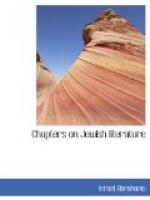Come forth, my friend, the
Bride to meet,
Come, O my friend, the Sabbath
greet!
The Shulchan Aruch is arranged in four parts, called fancifully, “Path of Life” (Orach Chayim), “Teacher of Knowledge” (Yoreh Deah), “Breastplate of Judgment” (Choshen ha-Mishpat), and “Stone of Help” (Eben ha-Ezer). The first part is mainly occupied with the subject of prayer, benedictions, the Sabbath, the festivals, and the observances proper to each. The second part deals with food and its preparation, Shechitah, or slaughtering of animals for food, the relations between Jews and non-Jews, vows, respect to parents, charity, and religious observances connected with agriculture, such as the payment of tithes, and, finally, the rites of mourning. This section of the Shulchan Aruch is the most miscellaneous of the four; in the other three the association of subjects is more logical. The Eben ha-Ezer treats of the laws of marriage and divorce from their civil and religious aspects. The Choshen ha-Mishpat deals with legal procedure, the laws regulating business transactions and the relations between man and man in the conduct of worldly affairs. A great number of commentaries on Karo’s Code were written by and for the Acharonim (=later scholars). It fully deserved this attention, for on its own lines the Shulchan Aruch was a masterly production. It brought system into the discordant opinions of the Rabbinical authorities of the Middle Ages, and its publication in the sixteenth century was itself a stroke of genius. Never before had such a work been so necessary as then. The Jews were in sight of what was to them the darkest age, the seventeenth and eighteenth centuries. Though the Shulchan Aruch had an evil effect in stereotyping Jewish religious thought and in preventing the rapid spread of the critical spirit, yet it was a rallying point for the disorganized Jews, and saved them from the disintegration which threatened them. The Shulchan Aruch was the last great bulwark of the Rabbinical conception of life. Alike in its form and contents it was a not unworthy close to the series of codes which began with the Mishnah, and in which life itself was codified.
BIBLIOGRAPHY
Steinschneider.—Jewish Literature, p. 213 seq.
I.H. Weiss.—On Codes, J.Q.R., I, p. 289.
ASHER BEN YECHIEL.
Graetz.—IV, p. 34 [37].




